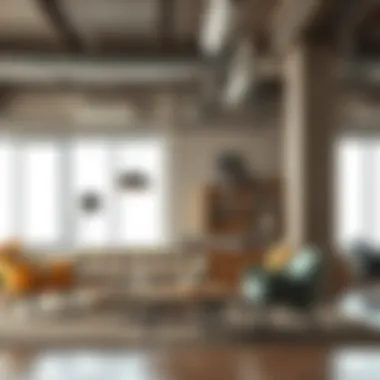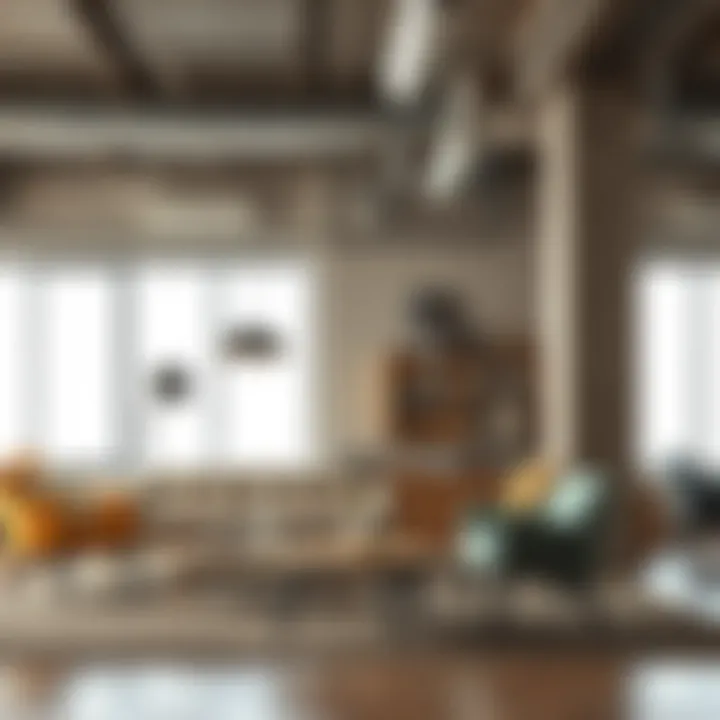Exploring the Metro Furniture Store: Trends and Insights


Intro
In the heart of bustling urban environments, metro furniture stores have carved their niche, reflecting the needs and tastes of modern city dwellers. These establishments are more than just places to shop; they are a hub for creativity, innovation, and functionality. As urban living continues to rise, so too does the demand for furniture that combines style with practicality. Understanding the essence of these stores opens a curtain into the intricate design philosophies and trends that showcase how our living spaces can be optimized to fit contemporary lifestyles.
Metro furniture stores often serve as a barometer for changing aesthetic values and practical requirements of city life. From compact designs that maximize space to sustainable materials that speak to the eco-conscious consumer, these stores respond dynamically to evolving trends. This article aims to peel back the layers of metro furniture, exploring the currents that shape its offerings and the inspirations behind its unique styles. Whether you’re a homeowner looking to refresh your space or a designer keen on the latest trends, the insights gathered here aim to illuminate the path towards styling your urban abode.
Foreword to Metro Furniture Stores
In an ever-evolving urban landscape, metro furniture stores have become essential hubs for city dwellers seeking style and functionality. These establishments cater to a growing population that calls the city home—where space is often limited but the appetite for design innovation is insatiable. Understanding what metro furniture stores represent is crucial for homeowners, designers, and DIY enthusiasts alike, as they offer a window into contemporary living solutions.
Metro furniture stores are not just retail spaces; they embody a lifestyle and a mindset that values efficient use of space while keeping aesthetics in check. By their very nature, these stores provide a curated selection of pieces that reflect the life of a city. Their significance goes beyond just selling furniture; they play a pivotal role in inspiring how urban environments can harmonize form and function.
Definition and Origins
Metro furniture refers to the style and variety of furniture designed with urban living in mind. The concept traces its roots back to the mid-20th century when cities began to expand rapidly. The need for adaptable living solutions led to an explosion of designs focusing on minimalism, creativity, and efficiency.
Examples of such designs can be seen in the small, modular sofas that easily adjust to various room sizes, or in tables that can transform from a compact dining space to an extended one suitable for gatherings. This evolution signifies a shift in how we perceive and utilize our living spaces, pushing the boundaries of what’s possible in smaller environments.
The Rise of Urban Living
Urban living has seen a meteoric rise over the past few decades, with more individuals and families opting for city life. This phenomenon arises from multiple factors: accessibility to jobs, entertainment, cultural experiences, and the vibrancy of metropolitan areas. In response, furniture stores have adapted to this trend by offering solutions tailored to the unique challenges urban life poses.
As space in cities shrinks, the retrofitting of smaller apartments and homes becomes paramount. Metro furniture stores have responded effectively to these demands by providing items that are compact yet stylish. Think of multi-functional pieces, such as an ottoman that doubles as extra seating or a bed that folds up to become a modern sofa.
“In the heart of the city, where space is at a premium, innovation breathes life back into furnishings.”
Through understanding these dynamics, one gains insight into not just products, but into a lifestyle that prioritizes adaptability and modernity. The offerings found in metro furniture stores are not just about materials and finishes; they communicate an ethos of living—one that appreciates convenience without sacrificing beauty.
Characteristics of Metro Furniture Stores
Metro furniture stores are distinct not only in their offerings but also in their approach to functionality and design. Understanding these properties is crucial for discerning homeowners, designers, and DIY enthusiasts seeking to enhance urban living spaces. The characteristics of these stores resonate with the demands of modern life, balancing aesthetics with practical needs. Hence, the following sections delve into the design aesthetic and product inventory that contribute significantly to the essence of metro furnishings.
Design Aesthetic
The design aesthetic at metro furniture stores often reflects the diversity and dynamism of urban life. It embodies the need for style that not only pleases the eye but also serves multiple purposes.
Minimalism
Minimalism is a hallmark of many metro furniture stores. It centers on streamlined forms, uncomplicated lines, and a (less is more) philosophy which aligns perfectly with urban spaces where clarity and open space are valued. The beauty of minimalism lies in its ability to create an uncluttered environment, promoting a sense of calm in an often chaotic city life.
Key Characteristics:
- Simplicity in Design: Most pieces tend to exclude unnecessary ornamentation.
- Visual Clarity: Simple shapes and neutral colors dominate, making it easier to blend with various interior styles.
The unique feature of minimalism is its focus on high-quality materials and well-thought-out spaces. However, it can sometimes feel too stark for some, lacking warmth without carefully chosen textiles and décor accents.
Industrial Elements
Industrial elements bring a rugged charm often associated with old factories and warehouses—an aesthetic prevalent in urban settings. This design choice has notably gained traction among city dwellers looking to incorporate an edgy, yet sophisticated feel in their homes.
Key Characteristics:
- Raw Materials: Rough finishes and exposed structures like brick, metal, and wood add to the overall design.
- Bold Statements: Features such as oversized lighting fixtures and metal furnishings often act as focal points in a room.
What sets industrial design apart is its blend of functionality and character. However, it can sometimes be overpowering in small spaces if not balanced properly with softer accessories.
Fusion of Styles
The fusion of styles in metro furniture stores allows for unique combinations that cater to diverse tastes. This eclectic approach creates a more personalized living environment. It is not uncommon to see blends of vintage, modern, and even rustic designs coexisting in harmony.
Key Characteristics:
- Personal Touch: Shoppers can curate their own style by mixing and matching pieces from different eras or design philosophies.
- Creativity in Design: This flexibility gives rise to originality that can truly reflect the homeowner’s personality.
The advantage here is the endless creativity possible with fusion styles. However, it may also lead to challenges in ensuring coherence in a space, where overly diverse elements could clash if not carefully considered.
Product Range
The product range in metro furniture stores plays a vital role in how these establishments meet the demands of space-restricted urban living. With compact living becoming the norm, a thoughtful selection can make all the difference.
Multi-Functional Furniture


Multi-functional furniture is a key player in the urban furniture scene. It meets the dual demands of style and utility, combining functions without compromising design integrity. Consider a sofa that easily transforms into a bed, or an ottoman that opens up for storage.
Key Characteristics:
- Versatility: These products can serve various purposes, which is crucial in smaller living spaces.
- Space-Efficiency: They help in maximizing usage, making the most out of limited square footage.
A unique feature is how designers seamlessly integrate clever mechanisms into attractive designs. However, this can sometimes result in higher prices that may be a barrier for some buyers.
Space-Saving Solutions
Space-saving solutions are a must in urban settings. This may include foldable tables, expandable dining sets, or innovative shelving that can adapt to different needs.
Key Characteristics:
- Compact Design: Items are purposefully designed to minimize footprint while providing functionality.
- Usability: This enhances the room’s functionality without sacrificing style.
The unique advantages lie in their ability to make small rooms feel larger and more versatile. But if not planned carefully, these items can inadvertently lead to a cluttered feel, especially if not designed with aesthetics in mind.
Unique écor Accents
Unique décor accents can provide that personal touch in any metro space. From artisanal handmade pieces to statement artworks, these accents infuse character and charm.
Key Characteristics:
- One-of-a-Kind Items: These pieces often tell a story, whether they are sourced from artisans or crafted from vintage finds.
- Cultural Representation: They often reflect local culture, keeping the neighborhood vibe alive in the home.
The primary advantage is the ability to create a visually captivating narrative that can enliven an otherwise standard space. However, the challenge is selecting pieces that complement the overall decor without turning an area into a display case.
Market Trends in Metro Furniture Design
As urbanization continues to expand, market trends in metro furniture design become increasingly significant. These trends represent not just aesthetic preferences but also respond to the practical needs of urban dwellers. Factors like limited space, sustainability, and technology integration are vital in shaping modern furniture. Understanding these trends can greatly assist homeowners and designers alike in making informed decisions that reflect contemporary lifestyles.
Sustainability in Design
Eco-Friendly Materials
The use of eco-friendly materials in furniture production is no longer just a trend; it’s become a necessity. These materials, which range from reclaimed wood to bamboo, support environmental conservation while providing beautiful, durable options for consumers.
A key characteristic of eco-friendly materials is their low environmental impact. They are usually sourced responsibly and can help reduce carbon footprints. This makes them a popular choice for buyers who prioritize sustainability in their purchasing decisions. Unique luster and variations in texture often found in such materials make pieces not only functional but also artistically appealing.
However, a few challenges exist. Often, products made from eco-friendly materials can come with a higher price tag. Buyers may weigh the expense against the long-term benefits of durability and environmental impact, which can be a deciding factor in their shopping experience.
Sustainable Manufacturing Practices
Sustainable manufacturing practices in the metro furniture industry focus on minimizing waste and using green technologies. A hallmark of these practices is energy-efficient production methods, which reduce the environmental footprint. This approach aligns with growing consumer demand for responsible sourcing and ethical manufacturing, making it an attractive option for brands aiming for longevity in the market.
One unique feature of these practices is the incorporation of design-for-disassembly principles. This allows furniture to be easily repaired or recycled at the end of its life cycle, thereby reducing overall waste. However, it may result in increased initial costs. Brands must balance the benefits of sustainability against these costs to appeal to price-conscious consumers while emphasizing long-term value.
Technological Innovations
Smart Furniture Solutions
Smart furniture solutions are making waves in metro design, integrating technology into everyday living. This trend includes furniture that can adapt to the needs of its users, like adjustable desks or sofas with built-in charging stations.
The challenge here is the balance between functionality and aesthetics. While smart furniture can offer incredible convenience and efficiency, critics argue that it sometimes compromises on design. However, as technology continues to advance, the industry is working towards creating solutions that complement both style and usability.
Online Shopping Trends
With the rise of e-commerce, online shopping trends have transformed how consumers engage with furniture stores. Virtual showrooms and augmented reality apps allow shoppers to visualize how a piece fits in their living space before making a purchase. This aspect enhances convenience, as shoppers can browse an extensive range without leaving their homes.
Yet, there is a drawback. Buyers can't physically interact with the pieces before purchasing, which can lead to dissatisfaction upon delivery. Retailers are counteracting this by offering generous return policies and detailed product descriptions. By leveraging technology smartly, metro furniture stores ensure the shift toward online shopping doesn't detract from customer satisfaction.
The Role of Metro Furniture Stores in Urban Spaces
In the heart of contemporary cities, metro furniture stores play a pivotal role, adapting to the dynamic environment and distinct demands of city dwellers. They are not just retail spaces; they function as cultural hubs, presenting a unique blend of functionality and style. Understanding their contribution to urban spaces offers a deeper appreciation of how these stores cater to the specialized needs of city living.
Catering to City Dwellers
Understanding Urban Needs
The essence of catering to city dwellers hinges on understanding urban needs. Urban environments often mean limited space, diverse lifestyles, and a blend of aesthetics. Furniture that resonates with the essence of metropolitan life isn't just about making a sale; it's about enhancing the living experience.
Key characteristics of this approach include:


- Space Efficiency: Urban homes tend to have less square footage. Many metro furniture pieces are designed to maximize utility without cluttering. Think of clever designs like foldable tables and sofas with built-in storage.
- Adaptability: Many city dwellers are frequently on the move. The versatility of pieces allows for easy relocation or reconfiguration of a living space.
Understanding urban needs emphasizes that metro furniture offers much more than mere aesthetic value. It acknowledges the constraints of city living while offering solutions that blend seamlessly into the lifestyle of its inhabitants, ensuring comfort and style together.
Customization Options
Customization options add another layer to the urban furniture landscape, catering to the demands of diverse tastes and requirements. This approach invites consumers to partake in the design process, fostering connection and commitment to their furniture.
The defining characteristic of customization is the ability to reflect personal style. By offering options, metro furniture stores can create pieces that resonate on a personal level with consumers. Enhancing the experience are:
- Personal Touch: Shoppers can pick colors, fabrics, and sizes, ensuring their furniture matches their vision.
- Unique Solutions: Often, unusual spaces demand one-of-a-kind solutions, and customization can meet those particular needs.
While customization can require more time and effort both from the consumer and the retailer, the long-term satisfaction it generates creates a loyal customer base ready to share their experiences and recommendations.
Collaborations with Local Designers
Spotlighting Emerging Talent
Collaboration with local designers is incredibly significant as it not only enhances the furniture offerings but also nourishes the creative ecosystem of the city. By highlighting emerging talent, these stores support the growth of local artists and designers.
The benefits of spotlighting these individuals include:
- Innovation: Local designers often bring fresh perspectives and innovative ideas that can set trends within the marketplace. Their proximity to the urban space allows for designs that deeply reflect the cultural nuances of the city.
- Community Connection: Engaging local talent fosters a sense of community and belonging, crucial for any urban area.
Through these collaborations, metro furniture stores can introduce unique products that stand apart from mass-produced items, offering consumers distinctive options that tell a story. This, however, comes with challenges such as ensuring quality control and establishing fair compensation for designers.
Unique Collections
Unique collections that arise from collaboration are a mainstay of metro furniture stores. They speak directly to the tastes of urban customers while also emphasizing craftsmanship.
Key traits of unique collections include:
- Artistic Expression: Each piece tells a story, often inspired by the local culture, thus allowing consumers to own a piece of the community's identity.
- Limited Availability: Such collections are often produced in smaller batches, granting a sense of exclusivity and appeal to homeowners who wish to have standout pieces.
The downside could be the higher price point due to limited production, but many consumers see the value in investing in quality, originality, and artistry.
Conclusion: Metro furniture stores are not just about selling chairs and tables; they're about crafting experiences. By understanding urban needs, offering customization, collaborating with local designers, and presenting unique collections, these stores become vital players in the urban landscape, blending comfort with identity in an ever-evolving city environment.
Consumer Behavior in Metro Furniture Stores
Understanding consumer behavior is vital when exploring metro furniture stores. The habits and preferences of buyers reflect broader trends in urban living and shape the market dynamics. People navigating city life often face unique challenges regarding space and functionality, which significantly influence their furniture choices. By recognizing these behaviors, retailers can tailor their offerings to meet customer needs more effectively. In essence, consumer behavior serves as a compass, guiding not only shopping decisions but also inventory strategies in these urban-centric stores.
Influences on Buying Decisions
Quality vs. Price
In the world of furniture, one of the most pressing aspects is the balance between quality and price. Buyers often grapple with the decision of whether to invest in higher-quality items that promise durability or opt for more affordable options that might not last long. Quality is often associated with longevity and craftsmanship, while price points can vary significantly.
A significant characteristic of the quality vs. price dilemma is perceived value. Many shoppers believe that if they pay more, they are guaranteed better quality. This is a prevalent thought process, especially among discerning customers who value longevity in their furniture. A solid piece of craftsmanship not only enhances home aesthetics but also reduces long-term costs as replacements may be less frequent.
However, the downside might include the initial investment required, which can be a stretch for some. Many buyers might find themselves caught in a paradox, waiting for sales or discounts to lighten the load on their wallets.
Style Preferences
Shoppers’ styles also play a significant role in their buying behaviors. Personal tastes, trends, and the overall aesthetic compatibility with existing home decor shape how consumers approach their furniture purchases. Are they drawn to modern minimalism or a more eclectic fusion of styles? These preferences can create a unique shopping experience.
One key aspect of style preferences is emotional connection. Furniture isn’t just a functional item; it often carries sentimental value or embodies a homeowner's identity. For some, elements such as color, texture, and design speak volumes, reflecting lifestyle and personality. When products resonate on a deeper level, the likelihood of purchase increases.
Yet, buyers can face challenges as well. For instance, staying attuned to ever-shifting trends might lead to hasty decisions or buyer’s remorse, particularly if the choices are more style-driven than practicality-focused. The reality is that striking a balance between aesthetic appeal and real-world functionality is critical for consumers in urban settings.
The Importance of Experience
In-Store Experiences
The physical shopping environment has a monumental impact on consumer decision-making. In-store experiences shape perceptions, guiding buyers through sensory interactions—from materials to layouts. Metro furniture stores often curate their environments to create inviting atmospheres where shoppers can envision how the pieces might fit into their own spaces.
A vital characteristic of the in-store experience is the interaction with products. Touching fabrics, sitting on seats, and viewing the proportions of furniture can affect buyer satisfaction greatly. This tactile exploration gives consumers confidence in their choices, an advantage that online shopping lacks. It's about building a personal connection with the furniture, which can often lead to transformative decisions.
However, with the change in shopping habits, the downside could be the potential for overcrowded spaces or pressure from sales staff, overshadowing the enjoyment of the experience.
Virtual Showrooms
On the other side of the spectrum, virtual showrooms have emerged as an innovative solution to meet changing consumer preferences. The rise of technology has granted buyers the ability to explore pieces without needing to leave their homes. Virtual environments are designed to replicate the in-store experience, showcasing furniture in realistic settings.


A notable feature of virtual showrooms is convenience. Customers can browse at their own pace, compare products, and even visualize how furniture might look in their homes using augmented reality features. This not only saves time but allows for a distinct exploration phase.
Nevertheless, the challenge with virtual showrooms lies in limitations of physical evaluation. The inability to physically interact with items can lead to uncertainty about the materials and quality, which may hinder some consumer confidence in purchasing. While the virtual world offers convenience, it still lacks the tactile feedback that many buyers seek.
"Knowing the market trends and consumer behavior in metro furniture stores can greatly enhance the shopping experience while ensuring a better fit for urban lifestyles."
Challenges Facing Metro Furniture Stores
Metro furniture stores face an array of challenges in today’s fast-paced retail environment. As urban lifestyles evolve, these stores must navigate not only market demands but also changes in consumer behavior and unexpected global events. Emphasizing this topic is crucial for understanding the dynamics that shape the furniture retail landscape and the strategies these stores must adopt to remain relevant and successful.
Competition with Online Retail
The competition from online retail is one of the most significant hurdles for metro furniture stores. With consumers increasingly gravitating towards the convenience of shopping from their homes, brick-and-mortar stores often find themselves in a tight corner. Online retailers like Wayfair and Amazon offer extensive selections, easy comparisons, and often better prices, appealing to price-sensitive shoppers.
In this scenario, metro furniture stores must differentiate themselves by focusing on their unique selling propositions, such as the tactile experience of furniture shopping. Shoppers can sit on a couch, feel the fabric, and see colors in real life—elements that no online store can replicate. To counteract this competition, local stores are finding avenues to enhance in-store experiences, from engaging product displays to knowledgeable staff who can offer personalized advice.
Adapting to Pandemic Changes
Shift in Shopping Habits
The pandemic has drastically altered shopping behaviors. With lockdowns and social distancing measures in place, many consumers turned to online shopping as their primary method of purchasing goods. This shift has led to a marked increase in website traffic for many furniture retailers while in-store traffic has waned. Understanding this change helps metropolitan furniture stores recognize the need to adapt their marketing strategies.
One significant aspect of this shift is the rise in consumers prioritizing safety and convenience. This change is not just a fleeting trend; it’s a permanent adjustment in how people approach shopping. As more shoppers blend their online browsing with occasional in-store visits, it creates a unique opportunity for hybrid shopping models to flourish.
Health and Safety Protocols
Health and safety protocols entered the forefront of consumer consideration during the pandemic. Furniture stores must now implement strict hygiene measures to instill customer confidence. This includes sanitizing surfaces regularly, providing hand sanitizers at entrances, and managing foot traffic through appointment-based visits or limited capacity.
These measures are not just beneficial; they have become an expectation. By placing a premium on health and safety, metro furniture stores can improve customer loyalty and attract a broader audience. Implementing protocols effectively demonstrates a store's commitment to the community's well-being, which can be a strong selling point.
Future Directions for Metro Furniture Stores
As we look ahead, the landscape of metro furniture stores is poised for transformation. The changes in urban living, coupled with evolving consumer preferences, herald a new chapter for these retailers. The future of metro furniture stores hinges on their ability to adapt and innovate, ensuring they remain relevant in a fast-paced world. Key considerations include embracing hybrid model strategies and expanding their global outreach. Both elements not only hold immense potential but also address the varying needs of a diverse consumer base.
Embracing Hybrid Models
The hybrid model signifies a blend of online and offline shopping experiences. This strategy is essential as it caters to modern shoppers who value convenience yet appreciate the tactile nature of product interaction. By combining the best aspects of both formats, metro furniture stores can elevate consumer experiences. Imagine walking into a store, feeling the materials and testing the comfort of a sofa, then utilizing technology to customize your order online or via a mobile app.
What’s more, this approach allows for a richer inventory management system. Retailers can track both online and in-store preferences, adjusting stock accordingly. Shoppers, meanwhile, can enjoy the luxury of exploring expansive catalogs without the constraints of physical space. Not to forget, it significantly enhances the stores' interaction touchpoints, catering to consumers' immediate needs as well as their adaptability to future needs.
Expanding Global Reach
International Market Trends
In today’s global marketplace, understanding international trends means recognizing the diverse tastes and aesthetics shaping furniture design. This aspect of international market trends is vital for metro furniture stores seeking to expand their influence. Furniture styles vary greatly from one region to another, illustrating unique cultural narratives. Capturing these narratives through product offerings can enhance global appeal.
Some key characteristics of international trends are rooted in sustainability and craftsmanship. For instance, consumers in Europe are increasingly drawn to eco-friendly materials, while in Asia, there's a growing appreciation for handmade items that reflect cultural heritage. This presents metro furniture outlets with a golden opportunity: by infusing these varying elements into their collections, they not only cater to aesthetics but also resonate with ethical consumer values.
However, there are disadvantages. Keeping up with these international trends requires a keen understanding of logistics, supplier relationships, and design adaptability. Balance is essential to avoid overwhelming local consumers who may prioritize traditional styles.
Cross-Cultural Design Elements
The fusion of cross-cultural design elements is another promising direction for metro furniture stores. This involves integrating various cultural aesthetics into a cohesive design philosophy. It facilitates a unique piece that reflects global influences yet serves local markets. A primary benefit is the ability to stand out in a crowded marketplace. Pieces that blend Scandinavian minimalism with Asian textiles or American vintage elements can create innovative products that attract consumers looking for something distinctive.
A notable feature of cross-cultural designs is their customizable nature. Consumers now lean towards personal expressions of style in their homes. Retailers can leverage this trend by offering customization options, allowing shoppers to pick designs that suit their cultural backgrounds or personal preferences.
Yet, a careful approach is needed. Flagrant appropriation of cultural elements without respect for their origins can backfire and lead to negative consumer perceptions. Sensitivity in design can convert cultural elements into advantages, enriching the overall consumer home experience while promoting global understanding.
When taken together, embracing hybrid models and cross-cultural fusions set the stage for a promising future for metro furniture stores. By evolving with market demands and being attuned to the broader cultural conversation, these stores can position themselves not just as retailers but as social contributors to modern urban living.
"The future is not something we enter. The future is something we create."
In essence, the journey forward for metro furniture stores is one filled with potential. With every adaptation, they can redefine what it means to furnish a contemporary urban space.
Closure
The exploration of metro furniture stores reveals more than just a shopping destination; it signals a shift in urban lifestyle and design ethos. As cities grow and evolve, so does the furniture that occupies their spaces. These stores serve as a mirror reflecting the tastes, needs, and aspirations of city dwellers.
The Lasting Impact of Metro Furniture
Metro furniture has undeniably carved a niche within the larger tapestry of interior design. For homeowners, this furniture provides not just style but also a functional solution to the challenges of urban living. Each piece often marries aesthetics with practicality, offering comfort without sacrificing space.
Consider how multi-functional furniture, such as a bed that doubles as a sofa or tables that can expand for guests, transforms a small apartment into a cozy haven. This dual purpose is essential for those navigating the crowded city life. For designers, the significance lies in the opportunity to innovate—bringing fresh ideas that blend modern art with everyday utility.
Additionally, local collaborations with artisans provide unique collections, infusing character and a sense of community into the designs. The result is a constantly evolving landscape of offerings that reflect not only individual preferences but also cultural narratives.
"City living requires creativity and adaptability; metro furniture embodies these principles by championing designs that are smart, stylish, and multifaceted."
In summary, the lasting impact of metro furniture is profound. It resonates with individuals seeking a harmonious blend of form and function, while challenging designers to reimagine what furniture can be. The future holds promise as these stores continue to cater to the dynamic needs of urban environments, making strides in sustainability and technology. Through every piece of furniture sold, there lies a story—of aspirations met and spaces transformed.















